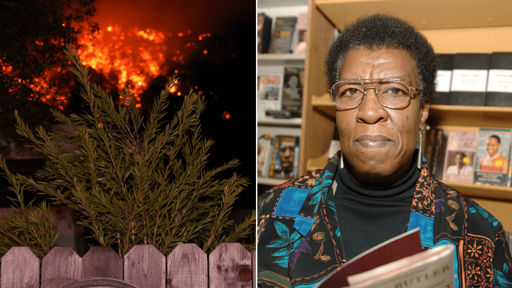Last June, Pasadena, California — about 11 miles from downtown Los Angeles — decreed that June 22 was Octavia E. Butler Day, in honor of the science fiction writer born in the city on that date in 1947. The Pasadena middle school Butler attended was renamed for her in 2022.
Butler, who died in 2006, has in the past few years been celebrated nationally, including posthumous profiles in the New York Times, New York magazine, and more. Particular attention has been paid to the prescience of her Parable series of books. Organizers and artists, like adrienne maree brown, spent the 2010s calling attention to Butler’s work — and her warnings.
The first book in the series, Parable of the Sower, published in 1993, begins on July 20, 2024, the 15th birthday of Butler’s protagonist, Lauren Oya Olamina. Olamina grew up in the fictional LA suburb of Robledo, described by Los Angeles journalist, essayist, and author Lynell George as “a struggling walled suburb… besieged by severe drought; class wars; violent, fire-setting scavengers; and a long-embattled population seized by political apathy.” In the second book, Parable of the Talents, published in 1998, a candidate runs using the slogan “Make America Great Again.”



I’m assuming that the response is going to be similar to that of the NYC area’s response to Hurricane Sandy.
Building and fire codes start to get updated in the region. This likely creates a few new classes of fire resistance ratings, including ratings that assume a lack of city water to fight a fire. For the highest ratings, wood is effectively banned. Given how cheap wood is to build with compared to other materials, this will drive up rebuilding costs.
The ratings get tied to new maps developed by an entity to determine fire risk. These maps will become very politically charged and may be dependent on local firefighting capacity. A lot of libertarians are going to hate having to pay for either sky high insurance or higher property tax to fund firefighters.
Development of the codes and maps take years, with significant input from insurance companies on what they may cover. There may be state involvement in insurance, similar to how flood insurance is a government insurance given how government policy affects risk.
Eventually, cities rebuild. The cities look different, with far more use of concrete masonry units reinforced with steel or FRP wraps and covered in fire resistant stucco. It doesn’t look too different from current stucco buildings, but there is a difference.
Also, some cities likely build in natural fire breaks, like green belts or fire canals. People don’t build up into the canyons like they used to unless they have a lot of money to build their concrete bunkers.
For one year, California is no longer a donor state in order to pay for rebuilding. Current donor states talk a lot of shit about this.
A plan of action becomes available for the rest of the country to apply to their codes as a way to deal with this cost. Several states legislate to make sure they don’t update their codes.